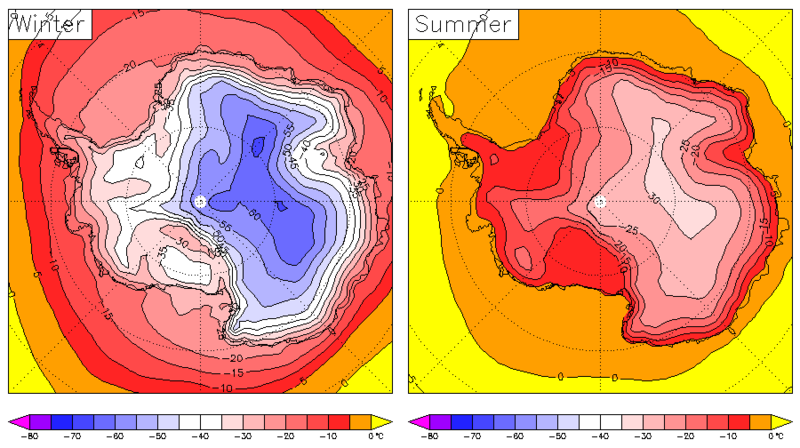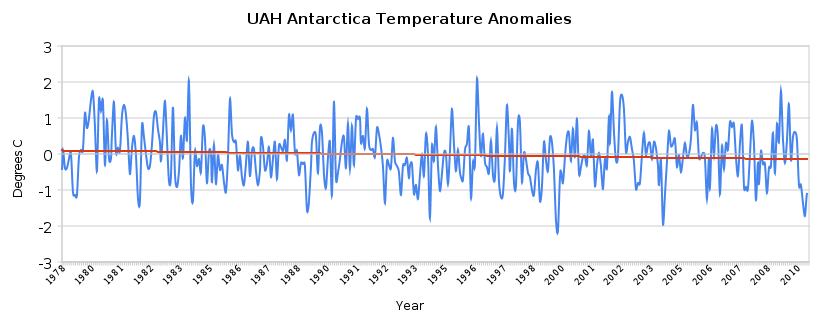Antarctic temperatures are far below freezing all year.
During June, I explained on WUWT that the University of Texas GRACE interpretations were wrong due to glacial rebound (isostasy.) Later in the summer they acknowledged that my explanation was correct.
a new study published in the September issue of Nature Geoscience suggests that the true melt rate might be much slower than that. (Access a PDF of the study here.) A joint team of American and Dutch scientists took another look at the GRACE data and found that Greenland and West Antarctica may be melting just half as fast the earlier studies estimated. As researcher Bert Vermeersen, a professor at Delft University of Technology in the Netherlands, told the AFP, the earlier estimates failed to account for glacial isostatic adjustment—the rebounding of the Earth’s crust after the end of the last Ice Age:
Hansen’s “non-linear” theory was ridiculous to begin with, and was undermined by the JPL study.
Under BAU [business as usual] forcing in the 21st century, the sea level rise surely will be dominated by a third term: (3) ice sheet disintegration. This third term was small until the past few years, but it is has at least doubled in the past decade and is now close to 1 mm/year, based on the gravity satellite measurements discussed above. As a quantitative example, let us say that the ice sheet contribution is 1 cm for the decade 2005–15 and that it doubles each decade until the West Antarctic ice sheet is largely depleted. That time constant yields a sea level rise of the order of 5 m this century.
His doubling has been halved. That means ice loss rates have not changed, which was obvious from sea level data. Temperatures in Antarctica are cold and getting colder.
How does this crap get through peer review? Ice doesn’t melt in summer temperatures of -10C, and Antarctica is getting colder.




What part of Hansen’s work should I look at to find this as “The Basis”? Reference please.
And as for the new study …
There’s an even more fundamental problem with this post.
The Nature Geoscience paper–assuming it’s right–affects the magnitude of the mass loss, but it does not affect the rate at which the loss is accelerating. If it was doubling before, it’s still doubling, just at quantities that are about half what was previously believed. Therefore, this statement is incorrect:
No, it doesn’t. There’s nothing about the new study that “means ice loss rates have not changed.”
Vellicogna 2009 says:
Nothing in the new study affects this statement at all. If it was right before, it’s still right. To “fix” Vellicogna’s graphs, all you have to do is divide the Y axis labels by 2. The shape of the lines doesn’t change at all.
Sea level rise rates have fallen over the last five years. Obviously we are not seeing an increase in ice sheet loss.
I’m not talking about sea level rise, I’m talking about your statement that halving the ice loss somehow says that “ice loss rates have not changed.” It doesn’t. Your claim that the idea of non-linear rise is “undermined by the JPL study” is also incorrect. Neither of these statements is true.
The JPL study–again, if it is right–affects the magnitude of the mass loss, but not the rate at which it is changing.
(PS: The link in “Access a PDF of the study here” is broken.)
“it is has at least doubled in the past decade and is now close to 1 mm/year, based on the gravity satellite measurements discussed above”
Did you read the rest of Hansens words, or do you omit this in order to try and fool your readers?
So you are acknowledging that he was wrong.
I’m pointing out that firstly it’s not the BASIS of Hansen’s prediction.
Second, he gave the example in order to show the difference between what Linear and Non-Linear and he specifically said that the decadal figure was purely speculative.
This point seems to be lost on you.
Yes it is. He predicted a continuous doubling, but the first doubling never happened and was based on crap science.
Things were so much simpler, back when the science was “settled”. I just had to write a cheque and hang my head in shame for breathing out so much…..
Does isostatic rebound lower sea levels? It seems to me that magma must fill the volume that a rising crust causes. Since the most flexible part of the earth’s is ocean floor, surely that will deform to provide the magma needed for rebound.
Glacial isostatic rebound is presumed to lower sea levels by about 0.3 mm/year. So if the actual sea level measurement from satellites is increasing at 3.0 mm/year, applying the isostatic rebound adjustment increases that sea level rise to 3.3 mm/year.
As the land rebounds, the ocean bottom/shelf margins sink ever so slightly so there is more volume for the existing ocean water to occupy.
But I have never seen how this is calculated.
In my mind, there are huge areas of continental shelf which are now below sea level (having been depressed by the glaciers in the last number of ice ages) but are now rebounding and reducing the volume that the ocean can occupy. Hudson Bay, the Baltic Sea, the North Sea, the Arctic Archipelago, the Kara Sea, the Barents Sea, the Laptev Sea and the Pacific coast of Canada and Alaska are examples of this.
Intuitively, the isostatic sea level adjustment should have the opposite sign but I’m sure it is very complicated.
I’m happy that the volume of the Earth is constant, so raising crust anywhere will increase the volume locally above its original level. Thus crust elsewhere must sink to keep the volume constant. If the sinkage is entirely continental then little sea-level effect would be seen I guess, whereas if the more flexible ocean floor gives up the slack it should drop sea-levels?
So there is food for thought to suggest Ice sheets melting deforms the crust positively in one place allowing a deformation negatively in another.
Well enough, though we suspect that over time ocean elevations have been significantly higher or lower than today.
So much room to define what is happening. Really worth contemplation and theory.
It, I mean mans understanding of Climate and Earth’s actions does seem to be bigger than our current constructions. As if to say, go with the flow, Earth really has the upper hand.
It is really the weighted-average depth of the ocean that is the issue.
An interesting example is the Cretaceous flooding of the continents – which maxed out at 95 million years ago. The Atlantic ocean was just opening up/was relatively young and it was only 1500 metres to 2000 metres deep. New ocean basins form at shallow depth and it takes about 100 million years for a new ocean basin to sink in the mantle and reach its mature depth of 4000 to 6000 metres deep.
The weighted-average depth of the oceans was therefore lower and the oceans had nowhere to go except onto the low-lying continental margins. Europe, Arabia, North Africa, South Asia and North America from Texas to Inuvik to Hudson Bay was flooded by shallow ocean. One can also imagine how this shallow warm water might have flowed into the Arctic ocean and kept it much warmer than today. Hence dinosaurs in Alaska, Eocene Arctic warmth.
The current ocean covering lots of shallow glacial-depressed continental shelf margin and rebound should make the weighted average depth increase over time rather than decrease, considering all the ocean bottom/mantle responses.
Wiki on this.
http://en.wikipedia.org/wiki/Post-glacial_rebound
Infected by global warming I’m afraid, but the rest of the article is fascinating.
Please do the numbers. To raise global sea level by 1 metre 158,000 cubic kilometres of ice must melt (97,000 cubic miles). And that figure is arrived at using the silly assumption there is a 1 metre high wall bounding all the oceans. I don’t know how to work out the overflow but it will need much, much more ice melt. Now work it out for 5 metres this century… sheesh! Now go work out how much energy will be needed to melt all that ice in 100 years. The sun would have to go nova!
Blast! Gave the wrong cubic kilometre number. Should be 397,000 cubic kilometres.
Pingback: MORE COLUMNS ON GLOBALONEY FROM CLIMATE DEPOT | RUTHFULLY YOURS